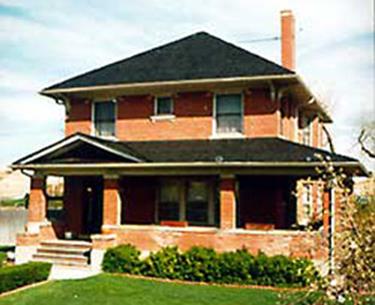Aurora has 34 historic landmarks, 2 historic districts, and 6 cultural heritage sites. A few are listed below. Get the Historic Landmark Brochure here.
DeLaney Farm Region
DeLaney Farm Historic District
170 South Chambers Road-Ward III
Built: 1902-Landmarked 1989
Local Historic Landmark
The DeLaney Farm Historic District encompasses 158 acres of open space and restored farm buildings that date from 1866 to 1945. The buildings include the historic Delaney Round Barn and John Gully Homestead House. This area was originally used by the DeLaney family for raising horses, dairy cattle, and other livestock. The DeLaney Farm Historic District is a valuable example of the history of farming and ranching in the Aurora area from the 1880’s.
John Gully Homestead House
170 South Chambers Road-Ward III
Built 1866-1871-Landmarked 1986
National Register of Historic Places
Aurora Landmark #3
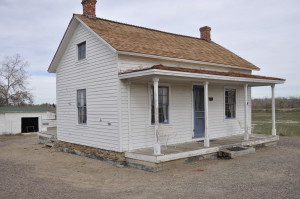 This small house is the oldest surviving home in Aurora. The ranch, house, stables, and corrals that make up the Gully Family homestead were originally located at Mississippi Avenue and Chambers Road, where this Irish immigrant family raised cattle and horses. The City of Aurora purchased the house and stable, moving them to the current site and restoring the house in 1982. It is still owned by the City of Aurora. 86000022 – Gully Homestead – web
This small house is the oldest surviving home in Aurora. The ranch, house, stables, and corrals that make up the Gully Family homestead were originally located at Mississippi Avenue and Chambers Road, where this Irish immigrant family raised cattle and horses. The City of Aurora purchased the house and stable, moving them to the current site and restoring the house in 1982. It is still owned by the City of Aurora. 86000022 – Gully Homestead – web
DeLaney Round Barn 170 South Chambers Road- Ward III
Built: 1902-Landmarked 1989
National Register of Historic Places
Aurora Landmark #9
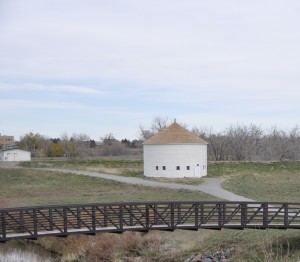 Originally constructed as a grain silo, this round building was converted into a two-story cow barn around 1912. Perhaps the only surviving round barn in Colorado, its exceptional construction and engineering are believed to be the work of an itinerant carpenter. The John DeLaney family lived in a home across Toll Gate Creek and raised livestock. The barn has been restored and houses an exhibit on agricultural and dairy farming in the Aurora area. It is owned by the City of Aurora.
Originally constructed as a grain silo, this round building was converted into a two-story cow barn around 1912. Perhaps the only surviving round barn in Colorado, its exceptional construction and engineering are believed to be the work of an itinerant carpenter. The John DeLaney family lived in a home across Toll Gate Creek and raised livestock. The barn has been restored and houses an exhibit on agricultural and dairy farming in the Aurora area. It is owned by the City of Aurora.
Coal Creek Schoolhouse 170 South Chambers Road-Ward III
Built: 1928-Landmarked 2001
Local Historic Landmark
Aurora Landmark #18
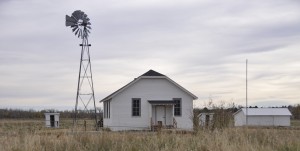 For generations of children growing up on the prairie surrounding Aurora, learning usually took place in a one-room schoolhouse. The original Coal Creek School, located near the Edward Smith Farm, burned to the ground around 1927, and this replacement was constructed during the next year. The school taught grades one through eight and also served as a community center until 1960. The schoolhouse and associated buildings have been moved three times; the second move brought it to the Beck Recreation Center/Springhill Park in 1976, and the third move brought it to the DeLaney Farm Historic District at 1st Avenue and Chambers Road.
For generations of children growing up on the prairie surrounding Aurora, learning usually took place in a one-room schoolhouse. The original Coal Creek School, located near the Edward Smith Farm, burned to the ground around 1927, and this replacement was constructed during the next year. The school taught grades one through eight and also served as a community center until 1960. The schoolhouse and associated buildings have been moved three times; the second move brought it to the Beck Recreation Center/Springhill Park in 1976, and the third move brought it to the DeLaney Farm Historic District at 1st Avenue and Chambers Road.
Original Aurora Region
Centennial House 1671 Galena Street- Ward I
Built 1890-Landmarked 1993
National Register of Historic Places
Aurora Landmark #11
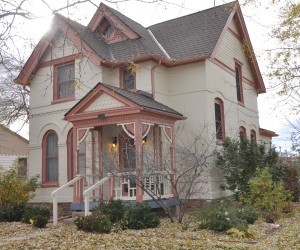 Centennial House is a Queen Anne Victorian style home. It is the oldest of the nine remaining houses Donald Fletcher built for his speculative community east of Denver. Like all Fletcher homes, it has indoor plumbing and an upstairs bathroom, a luxury considering both the time period and the arid surroundings. The City of Aurora purchased the house in 1990 and community members restored it for the City’s Centennial year. 96001278 – Centennial House NRHP Nom (web) LM Nomination – #11 Centennial House
Centennial House is a Queen Anne Victorian style home. It is the oldest of the nine remaining houses Donald Fletcher built for his speculative community east of Denver. Like all Fletcher homes, it has indoor plumbing and an upstairs bathroom, a luxury considering both the time period and the arid surroundings. The City of Aurora purchased the house in 1990 and community members restored it for the City’s Centennial year. 96001278 – Centennial House NRHP Nom (web) LM Nomination – #11 Centennial House
Fox Arts Center
9900 East Colfax Avenue-Ward I
Built 1946-Landmarked 1987
Local Historic Landmark
Aurora Landmark #5
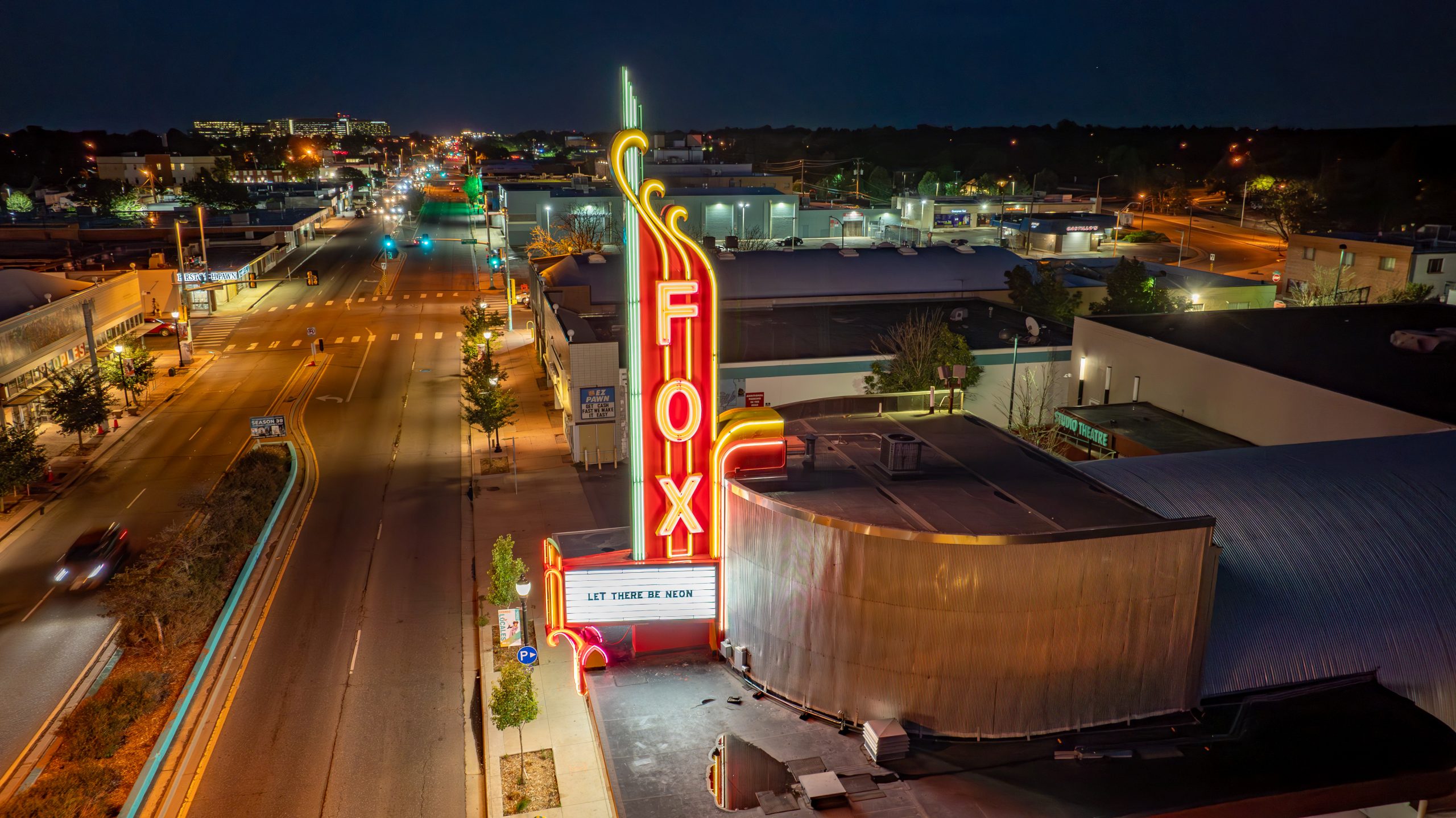 Aurora residents longed for a theater since motion pictures became popular, but the Great Depression and World War II made this type of construction impossible. As soon as the war ended, the Fox Inter-Mountain Amusement Corporation built this 670-seat theater, designed by architect Charles Strong. The building consists of a U.S. Army Quonset hut fronted with an Art Moderne entrance block, marquee, and neon sign. A fire forced the theater’s closure in 1981. The building was restored in 1983-85 and currently operates as a performing arts center owned by the City of Aurora. The marquee of the “theater of tomorrow,” as the Fox was originally dubbed, is 61 feet high, the same elevation as the D & F Tower in downtown Denver.
Aurora residents longed for a theater since motion pictures became popular, but the Great Depression and World War II made this type of construction impossible. As soon as the war ended, the Fox Inter-Mountain Amusement Corporation built this 670-seat theater, designed by architect Charles Strong. The building consists of a U.S. Army Quonset hut fronted with an Art Moderne entrance block, marquee, and neon sign. A fire forced the theater’s closure in 1981. The building was restored in 1983-85 and currently operates as a performing arts center owned by the City of Aurora. The marquee of the “theater of tomorrow,” as the Fox was originally dubbed, is 61 feet high, the same elevation as the D & F Tower in downtown Denver.
Fuller House 2027 Galena Street- Ward I
Built 1892-Landmarked 2001
National Register of Historic Places
Aurora Landmark #17
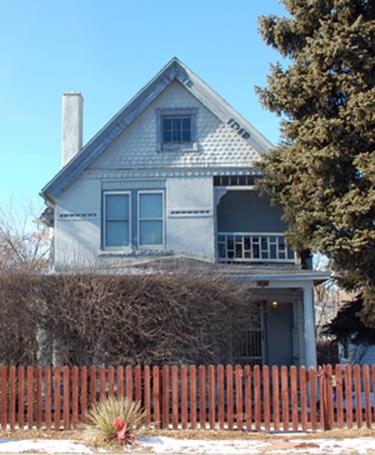 This extraordinary example of Queen Anne Victorian Architecture is one of the remaining ten original town of Fletcher homes. The distinctive decorative elements of the house, including the bar, circle trim, and fish scalle shingles on the front of the house, are well preseved and prominent. Other original elements such as the rhyolite door and window sills are still in place.
This extraordinary example of Queen Anne Victorian Architecture is one of the remaining ten original town of Fletcher homes. The distinctive decorative elements of the house, including the bar, circle trim, and fish scalle shingles on the front of the house, are well preseved and prominent. Other original elements such as the rhyolite door and window sills are still in place.
William Smith House 412 Oswego Court – Ward III
Built 1910-Landmarked 1986
National Register of Historic Places
Aurora Landmark #2
William Smith School 10000 E. 13th Ave – Ward I
Built 1931 – Landmarked 1986 Local Historic Landmark
Aurora Landmark #4
Built in the Art Deco style, Aurora’s first high school was named for the founder of the Aurora Public Schools. William Smith was instrumental in the formation of School District No. 28 in 1885 and served as school board treasurer for 50 years- the longest term of any school board officer in Colorado. Known today as Aurora West College Preparatory Academy, this historic building continues to serve Aurora.
Milliken House 1638 Galena St. – Ward I
Built 1891- Landmarked 1987 Local Historic Landmark
Aurora Landmark #6
H. M. Milliken, the first mayor of Fletcher, hosted the first town trustees (city council) meeting at his residence. The house was one of the first homes built on Galena Street, which was originally called Hathaway Street, constructed as part of the new speculative community east of Denver. Underneath the wraparound porch, added around 1910, is a typical Queen Anne Victorian style house. The name of this community later changed from Fletcher to Aurora. The home is privately owned.
Italian Villa 1785 Hanover St. -Ward I
Built 1925 – Landmarked 1988 – Local Historic Landmark
Aurora Landmark #8
Originally built as an Italian Restaurant, this Spanish Colonial Rivival building was later converted to residential use. The Italian Villa is associated with Dr. Henry Blank, a tuberculosis specialist, who lived in the house from 1934 to 1954. His wife continued to live in the home until 1982. The home is privately owned.
Thomas F. Gilligan House 1455 Beeler St. -Ward I
Built 1925 – Landmarked 1990
Local Historic Landmark
Aurora Landmark #10
Westinghouse and General Electric cooperated to build this Spanish Mission style house as an electric show home. Aurora First National Bank and Chamber of Commerce President, Thomas F. Gilligan, saw over 15,000 people visit his home for its grand opening gala. This event promoted not only modern homes complete with electric appliances, but also Aurora as a desirable suburb. This home has served as a residence and is now a residential healty cacility. It is privately owned.
Marshall Cowing House 1580 Dallas St. – Ward I
Built 1892 – Landmarked 2004
Local Historic Landmark
Aurora Landmark #19
Class division was apparent even in a small town like Fletcher. Homes built along Dallas Street and Galena Street during the same period reflect economic differences. The houses on both streets are Queen Anne Victorian style, but those on Dallas Street are smaller and less ornate than those on Galena Street. Marshall Cowing was the original owner of 1580 Dallas Strett. The McDowell family, owners of the Acacia Pharmacy on East Colfax Avenue, occupied this home in 1916. William H. Hawkins, another owner, ecame Aurora’s first paid fire chief in 1956. Until this time, the fire department had been organized and operated by volunteers. The house is privately owned.
Hornbein Building 9901 E. 16th Ave. Ward I
Built 1953 – Landmarked 2005
Local Historic Landmark
Aurora Landmark #20
The Hornbein Building, formerly the Martin Luther King Jr. Library and Reading Room, was designed by premier Denver Architect Victor Hornbein in 1953, and served as Aurora’s first independent library building. The building is “Usonian,” a style developed by Frank Lloyd Wright that uses a variety of natural finishes and open interior spaces. The style is influeneced by traditional Japenese design. The Hornbein Building had been in continueal service to the city of Aurora and its citizens as a library, reading room and city office space since its dedication on May 23, 1954. The city of Aurora owns the building.
Robidoux House 1615 Galena Street – Ward I
Built 1913 – Landmarked 2011
National Register of Historic Places
Aurora Landmark #25
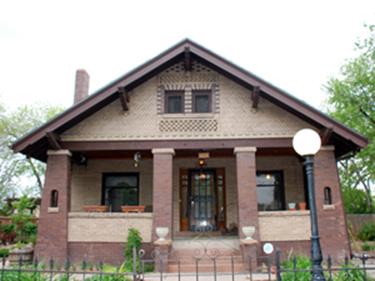 The Robidoux House is an excellent example of craftsman architecture. Detailed brickwork provides a decorative architectural element on the exterior, and the interior of the house reflects the craftsman influence in the quarter-sawn oak woodwork and built-in cabinetry. The house was commissioned by Mary Jane lavina Girard Robidouz, the widow of Albert Ribidoux, a succesbul wheat farmer and rancher from Kansas. Afer her husband’s untimely death in 1912, Mary Jane Robidoux moved to Aurora and invested in the design and construction of one of the finest Craftsman style homes on Galena Street.
The Robidoux House is an excellent example of craftsman architecture. Detailed brickwork provides a decorative architectural element on the exterior, and the interior of the house reflects the craftsman influence in the quarter-sawn oak woodwork and built-in cabinetry. The house was commissioned by Mary Jane lavina Girard Robidouz, the widow of Albert Ribidoux, a succesbul wheat farmer and rancher from Kansas. Afer her husband’s untimely death in 1912, Mary Jane Robidoux moved to Aurora and invested in the design and construction of one of the finest Craftsman style homes on Galena Street.
The Stanley Marketplace 2501 N. Dallas St. -Ward I
Built 1954 – Landmarked 2015
Local Historic Landmark
Aurora Landmark #27
The Stanley Marketplace currently houses an innovative commercial venture that pays homage to the history of this industrial site, and its founder, Robert Stanley. A groundbreakingh test pilot and engineer, Bob Stanley, established Stanley Aviation manufactiuring plant in northwest Aurora in 1954, which eventually became the city’s largest employer. The Stanley Avaition Plant produced a number of ejection seats and other het aircraft components, primarily used by the U. S. Air Force. The Stanley Marketplce is significant for its founder, for its contribution to military history, and for its architecture as an industrial example of the international style.
St. Therese Catholic School 1200 Kenton St. – Ward I
Built 1956 – Landmarked 2007
Local Historic Landmark
Aurora Landmark # 23
St. Therese Catholic School has educated tens of thousands of children since it welcomed its first students in 1956. It was built in response to the tremendous growth enjoyed by Aurora in the years after World War II. St. Therese, established in 1926 as Aurora’s first Roman Catholic Parish, purchased 48 lots on Kingston Street in 1949 with plans for a new church, school, and convent. 1953 saw construction begin on the school adn the first students enrolled in September of 1956. In 1960, the classroom building doubled in size and a large gymnasium was added later that decade.
St Theresa Parish Historic District 1243 Kenton St. – Ward I
Built 1951056 – Landmarked 2012
Local Landmark District
Population Growth experienced in Aurora after World War II, led to the construction of a new Catholic Church complex on an entire residental block at 12th and Kenton Streets. It was completed between 1951 and 1956. The St. Therese Parish Historic District is comprised of five buildings: Chruch, K-8 grade school, convent, rectory, and four-car garage. The St. Therese Parish is significant for its contribution to Aurora’s social history, and served many spiritual and community needs, while the school educated tens of thousands of student.
Military Landmarks
Red Cross Building & Memorial
The Red Cross building was demolished in 2015, but the Memorial is still standing.
12862 East Montview Blvd.- Ward 1
Built 1918-Landmarked 1999
Local Historic Landmark
Aurora Landmark #15
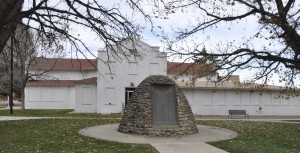 Soldiers recuperating at Fitzsimons General Hospital knew they could rely on the Red Cross Building as a refuge from army life. Built in 1918, the building was designed in the Mission Revival style common to U.S. Army Posts of the southwest. Surrounded by landscaped grounds, the building featured several fireplaces, a performance stage, and a large auditorium/recreational room. On the south side of the building stands a monument dedicated to the memory of officers, nurses, and enlisted men in the U. S. Army Medical Corps who lost their lives in the line of duty. The floor plan or “footprint” of this building was originally designed in the shape of the Red Cross. LM Nomination – #15 Red Cross
Soldiers recuperating at Fitzsimons General Hospital knew they could rely on the Red Cross Building as a refuge from army life. Built in 1918, the building was designed in the Mission Revival style common to U.S. Army Posts of the southwest. Surrounded by landscaped grounds, the building featured several fireplaces, a performance stage, and a large auditorium/recreational room. On the south side of the building stands a monument dedicated to the memory of officers, nurses, and enlisted men in the U. S. Army Medical Corps who lost their lives in the line of duty. The floor plan or “footprint” of this building was originally designed in the shape of the Red Cross. LM Nomination – #15 Red Cross
Guardhouses at Genral’s Park Colfax Avenue & Peoria Street – Ward I
Built 1919 – Landmarked 1999
Local Historic Landmark
Aurora Landmark # 13
 Standing Sentinel at what was once the main entrance to the Fitzsimons General Hospital, these guardhouses reflect the Mission Revival architectural style found throughout the complex with their shaped parapets and smooth stucco walls. The guardhouses stand on the western border of the burgeoning health science campus on the old army hospital site. The guardhouses and gate were accurately restored to their original 1919 appearance in 2010 by the City of Aurora. The eagle medallions were hand sculpted to replicate the design of the orignal symbols for the military hospital.
Standing Sentinel at what was once the main entrance to the Fitzsimons General Hospital, these guardhouses reflect the Mission Revival architectural style found throughout the complex with their shaped parapets and smooth stucco walls. The guardhouses stand on the western border of the burgeoning health science campus on the old army hospital site. The guardhouses and gate were accurately restored to their original 1919 appearance in 2010 by the City of Aurora. The eagle medallions were hand sculpted to replicate the design of the orignal symbols for the military hospital.
Smoky Hill Region
Melvin School 4950 South Laredo Street- Ward VI
Built 1922-Landmarked 1984
National Register of Historic Places
Aurora Landmark #1
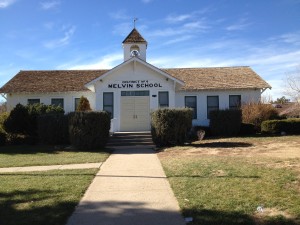 This two-room schoolhouse originally served the outlying community of Melvin. In 1949, the structure was moved to make way for the Cherry Creek Reservoir. After 17 years of use as a tavern, the Cherry Creek Valley Historical Society moved the school to its current location on the grounds of Smokey Hill High School. The building is owned and maintained by the Cherry Creek School District. Interesting note: in addition to normal duties, teachers were contracted to ”do all janitor work” and earned a salary of $100 a month. 84000790 – Melvin School NRHP Nom (web)
This two-room schoolhouse originally served the outlying community of Melvin. In 1949, the structure was moved to make way for the Cherry Creek Reservoir. After 17 years of use as a tavern, the Cherry Creek Valley Historical Society moved the school to its current location on the grounds of Smokey Hill High School. The building is owned and maintained by the Cherry Creek School District. Interesting note: in addition to normal duties, teachers were contracted to ”do all janitor work” and earned a salary of $100 a month. 84000790 – Melvin School NRHP Nom (web)
